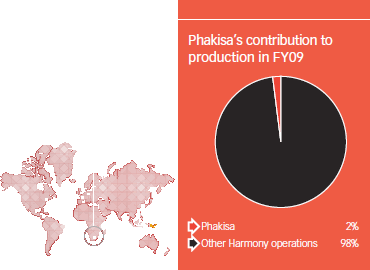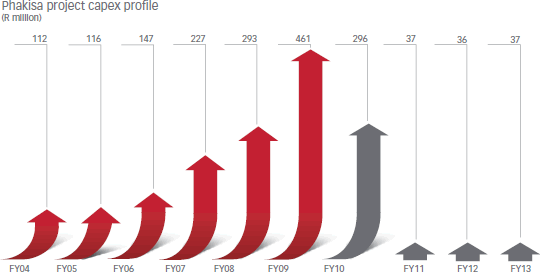Contents
- Corporate profile
- Key statistics 2009
- Key features 2009
- Operations at a glance
- FY09 – milestones
- Harmony strategy
- Chairman’s letter
- Chief executive officer’s review
- Review of operations
- Exploration overview
- Mineral resources and ore reserves
- Board of directors
- Executive management
- Corporate governance
- Directors’ report
- Report of the independent auditors (PDF - 37KB)
- Group annual financial statements (PDF - 312KB)
- Company annual financial statements (PDF - 123KB)
- Statement of subsidiary companies (PDF - 48KB)
- Investor relations
- Glossary of terms
- Administrative information
Phakisa

![Phakisa location [SA map]](i/sa_phakisa.gif)
Description
Phakisa mine, located near Odendaalsrus in the Free State, will mine the Basal Reef to a depth of some 2 400 metres once the project has been completed. Phakisa came into production in FY08. The Nyala shaft, 5.5 kilometres away, is used to hoist rock and is available as a second escape route. Ore mined at Phakisa is processed at Harmony 1 Plant, located some 20 kilometres away.
Harmony initially acquired Phakisa as part of the Freegold acquisition from AngloGold Ashanti Limited in January 2002. In September 2003, Harmony acquired these operations in their entirety.
The mine employs 1 844 people – 1 735 employees and 109 contractors. This will increase to 2 500 people in FY11.
Mineral resources and ore reserves
At the end of June 2009, Phakisa reported ore reserves of 5.295 million ounces of gold and mineral resources of 23.423 million ounces. The operation’s expected life-of-mine is 21 years. Potential upside from the exploitation of high grade pillars and at the Nyala shaft is being investigated. See the mineral resources and ore reserves section (PDF - 108KB) for more detail.
| Phakisa | Mineral resources | Ore reserves | |||||
| Measured | Indicated | Inferred | Total | Proven | Probable | Total | |
|---|---|---|---|---|---|---|---|
| Oz (000) | 1 050 | 9 337 | 13 036 | 23 423 | 56 | 5 239 | 5 295 |
| Tonnes (Mt) | 4.6 | 26.0 | 57.8 | 88.4 | 0.4 | 20.1 | 20.5 |
| Grade (G/t) | 7.03 | 11.17 | 7.02 | 8.24 | 4.98 | 8.11 | 8.05 |
Safety
Safety performance at Phakisa was excellent once again. Phakisa was also awarded, for the second consecutive year, the trophy for the safest mine in the Harmony group for FY09. There were no fatal accidents in FY09, and there has not been a fall of ground accident for more than 18 months. The LTIFR of 2.48 per million hours worked recorded for FY09, was a significant improvement on the 4.83 reported the previous year.
![Phakisa FIFR (per million hours worked) [graph]](i/phakisa_fifr.gif)
![Phakisa LTIFR (per million hours worked) [graph]](i/phakisa_ltifr.gif)
Phakisa key statistics:
| Unit | FY09 | FY08 | FY07 | |
|---|---|---|---|---|
| Production | ||||
| Volumes milled | 000 t (metric) | 185 | 13 | 1 511 |
| 000 t (imperial) | 204 | 34 | - | |
| Gold produced | kg | 691 | 125 | - |
| oz | 22 216 | 4 024 | - | |
| Average grade | g/t | 3.74 | 4.04 | - |
| oz/t | 0.109 | 0.118 | - | |
| Financial | ||||
| Revenue | R million | 171 | 28 | - |
| US$ million | 19 | 4 | - | |
| Cash costs | R/kg | 160 712 | 129 853 | - |
| US$/oz | 555 | 497 | - | |
| Cash operating profit | R million | 64 | 11 | - |
| US$ million | 7 | 2 | - | |
| Capital expenditure | R million | 461 | 293 | 277 |
| US$ million | 51 | 40 | 32 |
Phakisa key quarterly indicators: FY09
![Tonnes (000) [graph]](i/pha_ton.gif)
![Grade (g/t) [graph]](i/pha_grade.gif)
![Gold produced (kg) [graph]](i/pha_gold.gif)
![Cash cost (R/kg) [graph]](i/pha_cost.gif)
![Cash profit (R000) [graph]](i/pha_cash.gif)
The year in review
Monthly production at Phakisa increased to 25 000 tonnes in June 2009 from 6 000 tonnes in June 2008. Following delays caused by internal project constraints, revised plans and designs, the project is now on track. Development is a critical factor to the success of this operation, and good progress was reported with development of over 1 250 metres per month. A challenge encountered in the development of the project was a 40-metre downthrow fault which hampered raise development over three raise lines and necessitated changes to the development plan.
The capacity of the underground transport system has been increased with the commissioning of a second rail-veyor train, thus helping to ease the current bottleneck. Phase 1, which includes the ore handling system, water reticulation, ventilation systems and ice plants, was commissioned post year-end.
Three of the 10 planned ice plants have been installed and commissioned, significantly improving working conditions by lowering the water temperature (used for cooling) from 34°C to below 10°C. Reflecting both the improvement in environmental conditions and improved productivity, the monthly rate of development increased to 1 400 metres in June 2009 from 960 metres in July 2008.
Overall, volumes rose, amounting to 185 000 tonnes for the year. One of the most important targets for Phakisa in FY10 will be to increase the volume and sustain the rate of development and the recently-commissioned ice plants will play a key role in reducing underground temperatures further to support the production ramp-up.
The average grade at Phakisa declined to 3.74 g/t from 4.04 g/t in FY08, as mining was confined to a single raise line in a lower grade area. Flexibility, and hence grade, will improve somewhat in the coming year although the grade is still expected to fluctuate. Confidence in the ore reserve remains intact and an average grade of 7.66 g/t is expected to be achieved by FY12. Cash operating costs rose to R160 712/kg (US$555/oz). Phakisa reported a cash operating profit of R64 million (US$7 million).
Capital expenditure was relatively high at R461 million (US$51 million) as compared to R293 million in FY08.
Outlook*
The grade at Phakisa in FY10 will be higher than in FY09 as flexibility improves as a result of greater face length availability. The grade will, however, be lower than the expected life-of-mine grade as mining will take place in the lower-grade south area closer to the shaft. The average grade mined should increase from FY12 onwards when mining is scheduled to move into the higher-grade north areas. Some mining is also to be undertaken at the Nyala shaft where payable pillars are available for mining. For FY10, 32% of the total combined Phakisa/Nyala production will come from Nyala. This will continue for a few years until the extraction of these pillars is complete.
Tonnes milled will continue to increase in FY10, rising to 308 000 tonnes, while the grade is expected to be in the region of 4.6 g/t. Gold production of 1 428 kilograms (46 000 ounces) is expected in FY10. The cash cost** is expected to decline to R110 000/kg (US$443/oz) in FY12, when this operation is scheduled to reach full production.
Planned capital expenditure** for FY10 is R489 million (US$63 million) – R141 million (US$18 million) on on-going development and R52 million (US$7 million) on major equipment maintenance and other shaft capital. Capital planned for the main project is R296 million (US$38 million).
* Please refer to the forward-looking statements (PDF - 54KB)
** June 2009 money terms. The exchange rate as at 30 June 2009 of R7.72/US$ has been used for all forward-looking conversions.
![Phakisa: Five-year production profile [graph]](i/pha_fivep.gif)
Phakisa Project
Good progress continued to be made with the project and the anticipated capacity of some 83 000 tonnes per month is expected to be achieved by FY12.
![Phakisa Project [diagram]](i/phakisa_project_surface.gif)
![Phakisa Project [diagram]](i/phakisa_project_ug.gif)
Future milestones include:
- commissioning of third rail-veyor train in April 2010;
- commissioning of first phase of ice plants in September 2009;
- commissioning of water handling systems in September 2009; and
- commissioning of 20MW cooler in December 2010.
Key statistics
| First production | September 2008 |
| Full production (tonnes) | September 2011 |
| Forecast annual production | 7 880 kg; 253 360 oz |
| Capital expenditure | R1.6 billion; US$190 million (R1.2 billion spent to date) |
| Expected life-of-mine | 21 years |
| Average reserve head grade | 7.66 g/t |
| Life-of-mine ounces | 5.0 million |


